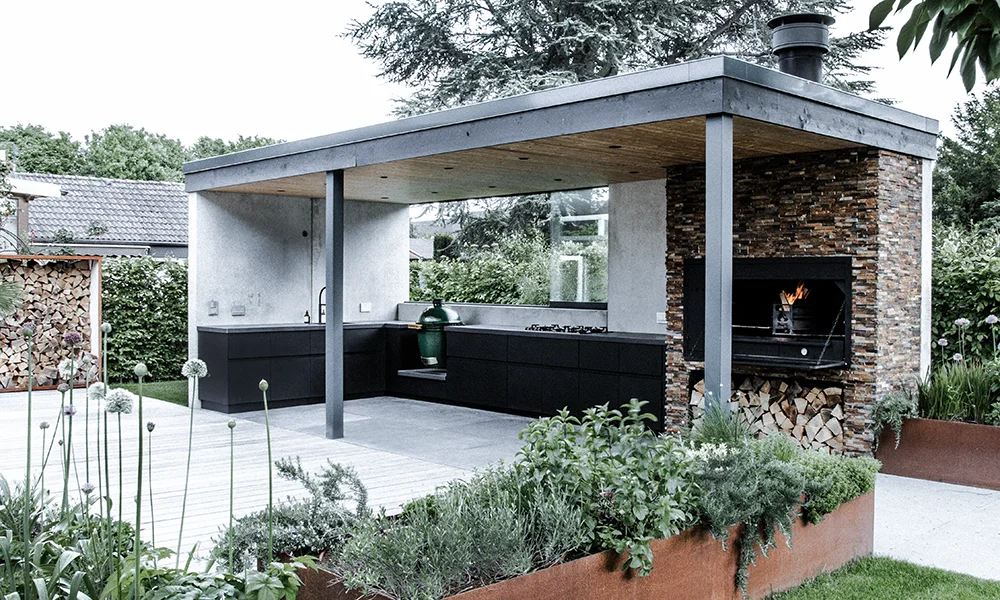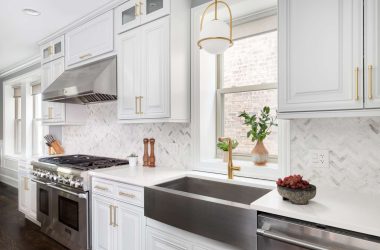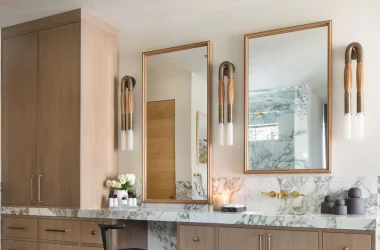An outdoor kitchen transforms your backyard into a vibrant space for entertaining, cooking, and creating memorable moments. But when it comes to building the perfect outdoor kitchen, one of the most crucial decisions is choosing the right material. Solid wood, plywood, and stainless steel are three popular options, each offering its unique advantages and drawbacks.
In this blog, we’ll compare the strengths and weaknesses of these materials while focusing on why stainless steel is the ideal choice for homeowners seeking long-lasting durability, low maintenance, and sleek modern aesthetics for their modern outdoor kitchen.
Key Considerations for Outdoor Kitchen Materials
When deciding on the best material for your outdoor kitchen, keep these essential factors in mind:
Weather Resilience – The ability to withstand moisture, sunlight, and temperature fluctuations.
Ease of Maintenance – How much work is involved in keeping the material in top condition.
Aesthetic Appeal – Does it complement the style of your space?
Cost and Longevity – Is it a worthwhile investment?
Let’s see how each material—solid wood, plywood, and stainless steel—performs in these areas.
- Solid Wood Outdoor Kitchens
Solid wood is a long-standing favorite for its beautiful natural appearance and timeless rustic charm. While it shines in looks, its practicality in changing weather conditions often falls short.
Advantages
Warm and Natural Aesthetic: Solid wood brings a cozy and inviting feel to outdoor spaces, making it perfect for traditional or farmhouse-style kitchens.
Customizable: It can be stained, painted, or carved for unique designs.
Premium Appeal: Specialty hardwoods like teak, cedar, and ipe offer high-end finishes for a more luxurious kitchen feel.
Disadvantages
Weather Resistance Issues: Wood is highly sensitive to water, humidity, and direct sunlight, often leading to warping, rotting, and cracking without proper care.
High Maintenance: Requires frequent sealing, staining, and protective coatings to maintain its beauty and durability.
Shorter Lifespan: Even the toughest woods will wear down over time, making it less durable than other materials in outdoor settings.
Costly Upkeep: Beyond the initial expense of premium wood, ongoing maintenance can quickly add to long-term costs.
Solid wood excels aesthetically but isn’t always practical for outdoor kitchens exposed to constant environmental elements.
- Plywood Outdoor Kitchens
Plywood is considered an economical and lightweight alternative to solid wood. While plywood can work indoors or in semi-sheltered outdoor areas, it struggles to hold up in uncovered spaces.
Advantages
Affordability: Plywood is less expensive than solid wood, making it an attractive option for homeowners on a budget.
Ease of Installation: Lightweight and simple to cut into shapes or designs, plywood is easier to handle during construction.
Marine-Grade Options: Marine-grade plywood is specially treated to resist moisture and is better suited for outdoor use than standard plywood.
Disadvantages
Durability Concerns: Even marine-grade plywood is vulnerable to delamination, swelling, and rot when exposed to continuous moisture, heat, and sunlight over time.
Appearance Limitations: Plywood doesn’t match the elegance of solid wood or stainless steel, even when coated with laminates or veneers.
Maintenance Required: Regular sealing and weatherproof coatings are necessary to preserve the structural integrity of plywood in outdoor settings.
Plywood works as a short-term, budget-friendly solution or for kitchens in partially covered areas, but its lifespan and performance are limited when exposed to harsh outdoor conditions.
- Stainless Steel Outdoor Kitchens
Stainless steel stands out as the ultimate material for outdoor kitchens. Its robust durability, low maintenance, and sleek aesthetic make it highly desirable for modern outdoor living spaces.
Advantages
- Unparalleled Durability
Stainless steel is virtually indestructible when exposed to outdoor elements:
Weather Resistant: Stainless steel doesn’t warp, rot, or crack like wood or plywood, making it an ideal choice for all climates.
Corrosion Proof: High-quality grades, such as 304 stainless steel or the ultra-durable 316 stainless steel, offer resistance to rust and corrosion, even in humid or coastal environments.
Heat Tolerance: Perfect for placement near grills and cooktops.
- Low Maintenance
Unlike wood or plywood, stainless steel requires very little upkeep:
Effortless Cleaning: A quick wipe down with soap and water is all that’s needed to keep your stainless steel outdoor kitchen gleaming.
No Sealing or Treatment Required: Unlike wood, it doesn’t require regular resealing or weatherproofing.
- Modern Aesthetic
Sleek and contemporary, stainless steel creates a high-end professional look that enhances the visual appeal of any outdoor space.
Its metallic tone complements other materials like stone countertops or tile backsplashes, creating a cohesive outdoor design.
- Hygienic Surface
Stainless steel is non-porous, meaning it doesn’t absorb water, food stains, or bacteria. This makes it one of the most sanitary options for an outdoor food preparation area.
- Long-Term Investment
While stainless steel requires a higher upfront cost than plywood (and sometimes wood), its unmatched durability ensures you won’t need replacements or repairs for decades. This makes it a cost-effective solution in the long run.
Disadvantages
Stainless steel isn’t perfect, but its drawbacks are minimal compared to its strengths:
Expense: Higher upfront cost compared to plywood. However, the durability and maintenance-free nature offset the investment in the long term.
Heat Absorption: Stainless steel can become hot in direct sunlight, but this can be addressed with shade structures or careful positioning during design.
Scratches and Smudges: Its surface can show fingerprints and minor scratches, but these are easy to clean or buff out.
Overall, stainless steel far surpasses other materials, offering exceptional performance and aesthetic that justify its cost.
Why Stainless Steel Is the Perfect Choice
If durability, ease of maintenance, and modern style matter most to you, then stainless steel is hands-down the best investment for your outdoor kitchen. It outperforms solid wood and plywood in nearly every category:
Resists weather damage with minimal upkeep.
Boasts a sleek and professional aesthetic.
Lasts for decades, saving you money in the long run.
Provides a hygienic food preparation surface.
While solid wood offers traditional charm and plywood may be ideal for low-budget setups, stainless steel offers the balance of quality and longevity that homeowners need for an outdoor kitchen meant to stand the test of time.
Choosing the right material for your outdoor kitchen is vital to ensure it remains functional and visually appealing for years to come. While wood and plywood may suit specific styles or budgets, stainless steel is the ultimate choice for those seeking durability, modern aesthetics, and minimal maintenance.







